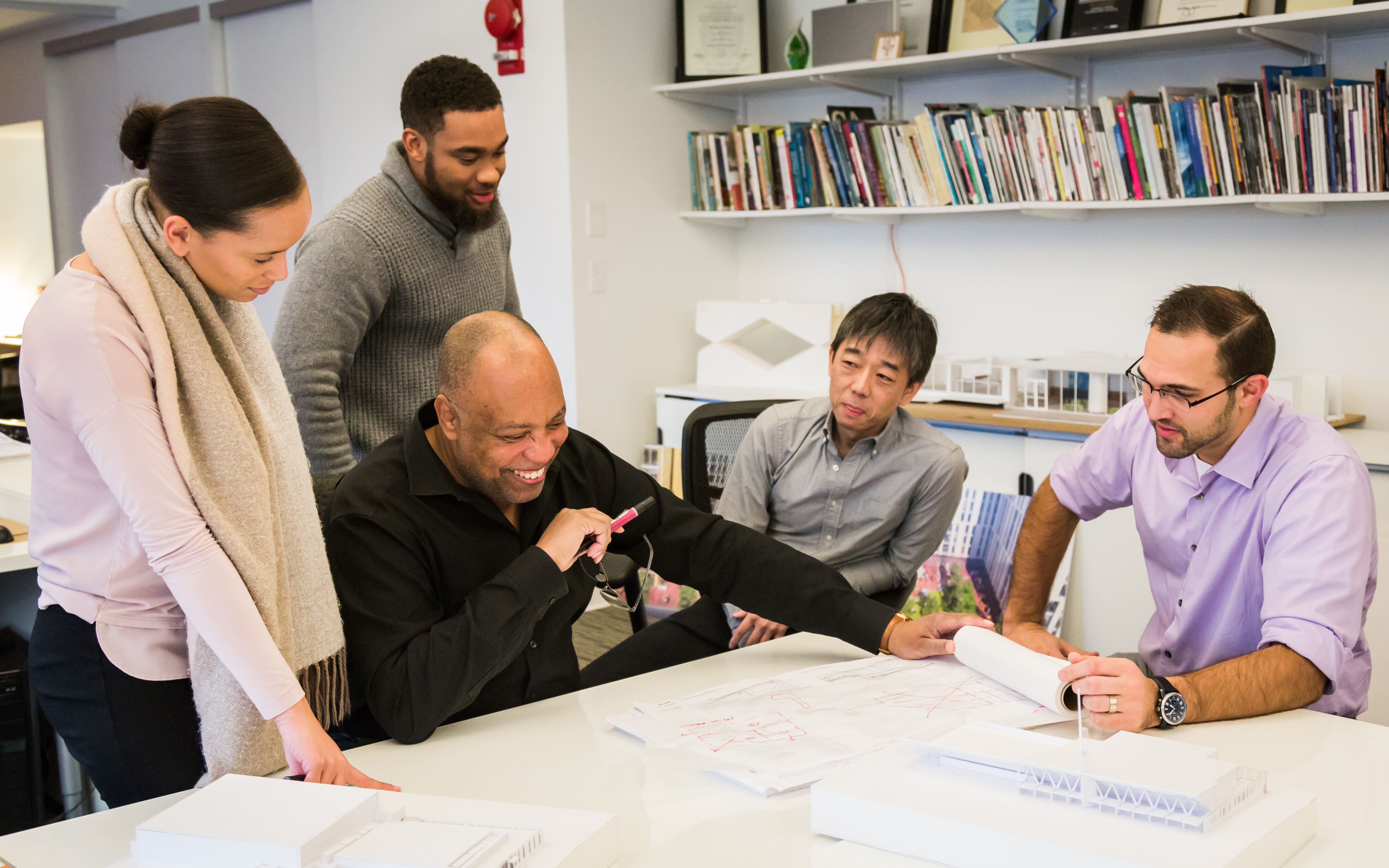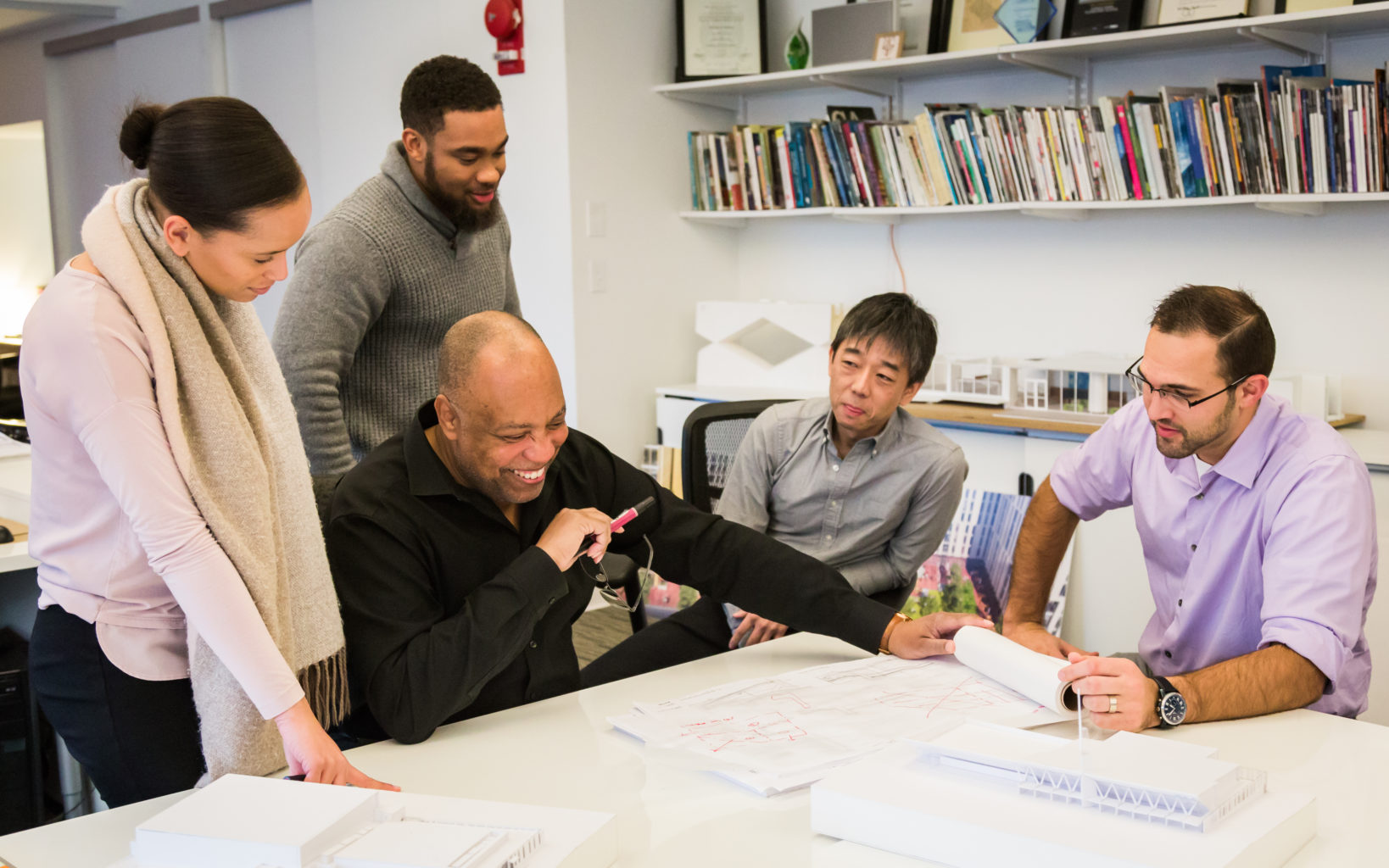Conversations about diversity, equity and inclusion are taking place across the nation with increased urgency, as individuals and organizations alike confront difficult truths about the Black experience in the U.S. and make it a priority to first listen, and then, to take concrete action to address systemic racism.
According to recent data from the National Council of Architectural Registration Boards (NCARB), there are over 116,000 licensed architects in the U.S., a 10% increase from 10 years ago. However, only around 2% of those architects are Black. How can the architecture profession begin to correct this inequity?
USGBC will publish a series of articles throughout the year on Black professionals in the green building industry. To begin this series, three architects generously shared their thoughts with USGBC on sustainability, LEED projects, and diversity and inclusion in the architecture profession:
- Melanie Ray, LEED Green Associate, AIA, NOMA, Fitwel Ambassador, is an associate at Hord Coplan Macht, Inc., in Baltimore, Maryland.
- Michael Marshall, FAIA, NOMA, NCARB, is the founder, president and CEO of Michael Marshall Design in Washington, D.C.
- Pascale Sablan, LEED AP, FAIA, NOMA, is an associate with Adjaye Associates and is the founder and executive director of Beyond the Built Environment in New York City.
What do you think most needs to change in architecture to make it more inclusive for Black professionals?
Melanie Ray: I think the practice in general needs to look beyond calls for increased access and diversity and truly focus on the meaning of inclusion. Since last spring, we have seen numerous firms, institutions and universities pour resources into programs and initiatives that are intended to create more black architects and architects of color; however, there is often no follow-through.
Is there a mentorship program in place that fosters the growth of architecture students and recent graduates so they are not only hired, but also retained? Do those individuals see themselves as future leaders within the company? Is equity and diversity training a requirement for those at the senior level to ensure that they foster their staff’s development? If we are not looking holistically at diversity and inclusion, then the industry will only be filling a void where talented designers are continuously pushed out.

Melanie Ray speaks to community members at a visioning meeting for Transform Poe, a project that will lay the foundations for the new Poe Homes community. Photo courtesty of Hord Coplan Macht.
Michael Marshall: I wrote an article outlining my idea for the creation of a LEED-like rating system for inclusion and diversity. Developers and architectural firms that have low minority membership and representation could team with diverse partners and team members, embracing diversity and inclusion, and then earn points. They could market that and generate revenue as a result of a high rating. There are numerous public-private partnerships here in D.C., where there is land that is D.C.-government-controlled and -owned and land that is being developed, not unlike around Buzzards Point, City Center or the historic campus of St. Elizabeth’s.
In these areas, there could be opportunities for developers to say, “We have a certain diversity rating, because we’ve done XYZ, we have teamed with smaller minority firms for our projects,” or “We have set up within our human resources department the priority and need to hire, and have hired more minorities and women.” That’s one of the ways I think that we can help to stimulate the desire to be more inclusive and equitable in both the practice of architecture and in development and contracting. If there’s a way to reward [equity and inclusion], so it’s more carrot than stick, and there’s financial incentive, I think we could see real progress.
If there were some outside agency, not unlike USGBC or some other council, that can monitor this and award the ratings, or a new organization is established for this work, that would be a good thing. That’s what I propose, to be specific about the professions involved with development—in particular for community development that involves taxpayer dollars, because the teams that develop these projects should look like the communities they are serving.

Michael Marshall at work with colleagues. Photo courtesy of Michael Marshall Design.
Pascale Sablan: In underserved communities, poorly appointed architecture perpetuates inequity. These inequities more often adversely affect communities of color. As an architect, I deeply value collaborative processes of creating environments that reflect and sustain diversity and the dignity of human life. Representation is quintessential to achieving diversity. I aspire to inspire marginalized groups to understand the important role they can have in deciding and designing their environments. Therefore, to make our profession more inclusive to Black communities requires dismantling injustices along the full pipeline of the profession, from academia through the recognition of the greatness and importance of their work.
- We need to be bespoke in our outreach and community engagement,
- Powerful in our removal of the racist infrastructure that keeps the Black community out of the profession,
- Diversify the curriculum and the professors,
- Create access to career opportunities and growth in an office,
- Give business owners access to project and development deals that would allow them to flourish and impact their community, and
- Promote representation of their contributions to society and the built environment in publications and award acknowledgments.

Pascale Sablan stands by wind turbines at the site of the LEED Platinum 888 Boylston project.
How does sustainability intersect with your other goals, whether in building design, social equity or some other aspect?
Ray: We cannot truly achieve sustainable development goals until all individuals have their basic needs met and are included in the vision of a sustainable future. As architects, our profession has taken a clear stance on climate change and the importance of designing efficient and sustainable buildings. However, we must also recognize that this includes fighting for equity in the built environment with regard to environmental and social justice. The profession of architecture puts us in the unique position of having the technical acuity to address these issues at a global level while also having intimate connections to the communities we work in. That is where I see my own career path being directed.
Marshall: Sustainability is very important, because if we’re doing things that are harmful to the environment, it affects everyone, including minorities, and often minorities are more vulnerable. We teamed with Cannon Design on the design of the University of the District of Columbia (UDC) Student Center. UDC is a historically black university and, at that time, it was very important for the president of the university to convey that they had a concern about the stewardship of our environment, of our cities, of our being. The thinking was that by having a new student center that was LEED Platinum (it was one of the few in existence at the time on the East Coast), it would give them an edge in marketing and recruiting students. Students interested in sustainability could say that they selected a university that truly cares about sustainability.

The LEED Platinum UDC Student Center. Photo credit: Sam Kittner.
We try to encourage our clients to focus on these things, and more and more frequently, they’re asking for things like this. It’s now just organic to what we do as architects, and our clients understand the value. Even the developers understand, because now there is a return on that investment. That return can position them to be more competitive. It’s not unlike when the Americans for Disabilities Act came into being, to design for accessibility, or people with special needs—now it’s the norm to do so. Focus on sustainability, green building materials, [reducing] carbon footprint, is now just the norm. There is a new generation that demands environmental stewardship.
Sablan: I am a proud LEED AP and advocate for design justice as well as environmental justice, which go hand and hand. My mission is aligned with USGBC where the “mission is to transform the way buildings and communities are designed, built and operated, enabling an environmentally and socially responsible, healthy, and prosperous environment that improves the quality of life.”
“You can’t manage what you can’t measure,” said W. Edwards Deming. USGBC and the LEED system inspired me to consider how we can develop a metric of accountability. During a time where the demand was to create a more “green society,” USGBC developed the how. Leveraging this mindset, in my advocacy work, I am constantly looking for statics and figures to help explain the issues and to advocate for change and to measure our progress.
What is your favorite LEED project?
Ray: One of my favorite projects completed by HCM is Green Street Academy, a 130,000-square-foot renovation of an early 20th century public school in West Baltimore. The project not only meets the requirements for a LEED Platinum building, but it also translates the innovative design solutions into sustainable learning opportunities for its students. Students are learning about the importance of green design by experiencing its impact firsthand in their daily schedules. As a firm, we continue to engage with them to foster the next generation of architects through our annual Architect for a Day program and participating in ACE Mentoring.

The LEED Platinum Green Street Academy in West Baltimore, Maryland. Photo credit: Tom Holdsworth Photography.
Marshall: The UDC Student Center, for two reasons. One is I that actually went to school there in the mid-1970s—that’s where I started my academic career. But I’m also proud that it is a LEED Platinum building on a major corridor here in D.C., Connecticut Avenue. It’s a true urban marker, a really strong symbol for our flagship university, and we were able to build it out toward the public realm. Usually, student centers are buried inside a campus and are often more central; but in this case, the university leadership understood the impact of welcoming the community in, to brand the university in the public realm, and to get the students out to the edge of the campus, to understand how they fit into the community. I’m very happy with what that project has accomplished.
Sablan: During my time at FxCollaborative, I had the distinct honor of working on the 888 Boylston project, which is the highest-performing speculative office building in all of New England. This is a LEED Platinum project that employed passive and active strategies to ensure not only a light touch on the environment, but also enhancement of the quality of life of those impacted by it. The building is crafted to optimize the indoor environment, office planning flexibility and building performance.
